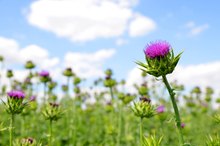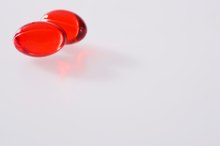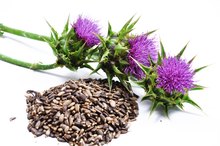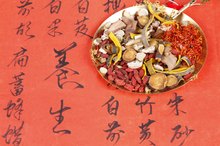What does fact checked mean?
At Healthfully, we strive to deliver objective content that is accurate and up-to-date. Our team periodically reviews articles in order to ensure content quality. The sources cited below consist of evidence from peer-reviewed journals, prominent medical organizations, academic associations, and government data.
- MedlinePlus: Roman Chamomile
- National Digestive Diseases Information Clearinghouse: Nonalcoholic Steatohepatitis
- Lipids in Health and Disease: Effects of Flavonoids on Sphingolipid Turnover in the Toxin-Damaged Liver and Liver Cells
The information contained on this site is for informational purposes only, and should not be used as a substitute for the advice of a professional health care provider. Please check with the appropriate physician regarding health questions and concerns. Although we strive to deliver accurate and up-to-date information, no guarantee to that effect is made.
Fatty Liver & Chamomile Tea
Fatty liver is a condition in which excessive levels of fat accumulate in the liver. In and of itself, fatty liver isn't a disease, but it is a condition that can eventually lead to inflammatory complications and thus pose a serious health threat. Although small-scale animal studies indicate that flavonoids in chamomile tea may have liver-protective effects, the website Medline Plus says that scientific evidence to confirm chamomile’s hepatoprotective properties is thus far insufficient.
If you are experiencing serious medical symptoms, seek emergency treatment immediately.
Causes of Fatty Liver
Nonalcoholic steatohepatitis, or NASH, is the form of fatty liver disease that occurs in people who drink little or no alcohol. Although 10 to 20 percent of all Americans have elevated levels of fat in their livers, only 2 to 5 percent suffer from NASH, which can lead to cirrhosis and cause permanent liver damage, according to the National Digestive Diseases Information Clearinghouse. NASH most often occurs in people who are middle aged and overweight or obese. Other risk factors for NASH include:
- oxidative stress involving the deterioration of liver cells
- insulin resistance,
- the release of inflammatory proteins
- or cytokines
- by fat cells
- Nonalcoholic steatohepatitis, or NASH, is the form of fatty liver disease that occurs in people who drink little or no alcohol.
Types of Chamomile Tea
Herbs for Liver Cysts
Learn More
Although they belong to different species, two plants are generally referred to as chamomile and have virtually identical medicinal properties. German chamomile is known scientifically as Matricaria recutita, while the scientific name of Roman chamomile is Chamaemelum nobile, according to the University of Maryland Medical Center website 13. Tea can be made by steeping the flowers of either plant in boiling water.
Ukrainian Study
Two researchers at Ukraine’s Kharkov Karazin National University conducted an animal study to assess the liver-protective effects of flavonoids in German chamomile against potential damage from substances known to be toxic to the liver 3. Specifically, the researchers sought to determine how chamomile flavonoids -- present in chamomile tea -- affect sphingolipid and ceramide metabolism in the livers of laboratory rats in which damage was induced by the introduction of carbon tetrachloride and/or ethanol. Dosing the laboratory animals with chamomile normalized sphingolipid and ceramide metabolism, which prevented the death of liver cells that might otherwise be caused by such toxins. Results of this study were published in the 2008 issue of “Lipids in Health and Disease. 4”
Review of Hepatoprotective Herbs
Milk Thistle and Liver Enzymes
Learn More
Researchers at the Himalayan Pharmacy Institute in Sikkim conducted a review of the scientific literature on herbs with liver-protective properties. In an article published in the April 2010 issue of the “International Journal of Research in Pharmaceutical Sciences,” they cite a 2006 study showing that an extract of chamomile effectively protected liver cells from inflammatory damage caused by paracetamol, known in the United States as acetaminophen.
No Definitive Proof of Efficacy
However, the agency says that the absence of adequate documented evidence of the herb’s effectiveness makes it impossible to recommend its use as a therapeutic application.
Related Articles
References
- MedlinePlus: Roman Chamomile
- Cleveland Clinic: Alcoholic Liver Disease
- University of Maryland Medical Center: German Chamomile
- Lipids in Health and Disease: Effects of Flavonoids on Sphingolipid Turnover in the Toxin-Damaged Liver and Liver Cells
- The Complete German Commission E Monographs; Mark Blumenthal (NOTE TO ED: P. 321)
- Health Information Library: Roman Chamomile. PennState Hershey/Milton S. Hershey Medical Center.
- Chamomile Fact Sheet. National Center for Complimentary and Integrative Health.
- Amsterdam, J., Shults, J., Soeller, I., Mao, J., Rockwell, K., Newberg, A. (2013). Chamomile May Have Antidepressant Activity in Anxious Depressed Humans - An Exploratory Study. Alternative Therapies in Health and Medicine. 18(5): 44–49.
- Rice, C. (2017). Essential Oil Dilutions & Conversions Guide. Mountain Rose Herbs.
- Sándor, Z., Mottaghipisheh, J., Veres, K., Hohmann, J., Bencsik, T., Csupor, D. (2018). Evidence Supports Tradition: The in Vitro Effects of Roman Chamomile on Smooth Muscles. Frontiers in Pharmacology. doi:10.3389/fphar.2018.00323.
- Shinomiya K, Inoue T, Utsu Y, Tokunaga S, Masuoka T, Ohmori A, Kamei C. (2005). Hypnotic activities of chamomile and passiflora extracts in sleep-disturbed rats. Biological and Pharmaceutical Bulletin.
- Srivastava, J. K., Shankar, E., & Gupta, S. (2010). Chamomile: A herbal medicine of the past with bright future. Molecular Medicine Reports, 3(6), 895-901. doi:10.3892/mmr.2010.377.
Writer Bio
Don Amerman has spent his entire professional career in the editorial field. For many years he was an editor and writer for The Journal of Commerce. Since 1996 he has been freelancing full-time, writing for a large number of print and online publishers including Gale Group, Charles Scribner’s Sons, Greenwood Publishing, Rock Hill Works and others.









